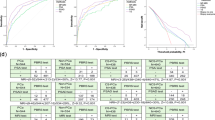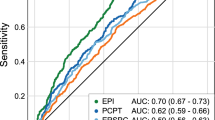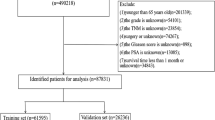Abstract
Background:
To adapt the well-performing European Randomized Study of Screening for Prostate Cancer (ERSPC) risk calculator to the Chinese setting and perform an external validation.
Methods:
The original ERSPC risk calculator 3 (RC3) for prostate cancer (PCa) and high-grade PCa (HGPCa) was applied to a development cohort of 3006 previously unscreened Hong Kong Chinese men with initial transrectal biopsies performed from 1997 to 2015, age 50–80 years, PSA 0.4–50 ng ml−1 and prostate volume 10–150 ml. A simple adaptation to RC3 was performed and externally validated in a cohort of 2214 Chinese men from another Hong Kong hospital. The performance of the models were presented in calibration plots, area under curve (AUC) of receiver operating characteristics (ROCs) and decision curve analyses.
Results:
PCa and HGPCa was diagnosed in 16.7% (503/3006) and 7.8% (234/3006) men in the development cohort, and 20.2% (447/2204) and 9.7% (214/2204) men in the validation cohort, respectively. The AUCs using the original RC3 model in the development cohort were 0.75 and 0.84 for PCa and HGPCa, respectively, but the calibration plots showed considerable overestimation. In the external validation of the recalibrated RC3 model, excellent calibration was observed, and discrimination was good with AUCs of 0.76 and 0.85 for PCa and HGPCa, respectively. Decision curve analyses in the validation cohort showed net clinical benefit of the recalibrated RC3 model over PSA.
Conclusions:
A recalibrated ERSPC risk calculator for the Chinese population was developed, and it showed excellent discrimination, calibration and net clinical benefit in an external validation cohort.
This is a preview of subscription content, access via your institution
Access options
Subscribe to this journal
Receive 4 print issues and online access
$259.00 per year
only $64.75 per issue
Buy this article
- Purchase on Springer Link
- Instant access to full article PDF
Prices may be subject to local taxes which are calculated during checkout



Similar content being viewed by others
References
Schröder FH, Hugosson J, Roobol MJ, Tammela TL, Zappa M, Nelen V et al. Screening and prostate cancer mortality: results of the European Randomised Study of Screening for Prostate Cancer (ERSPC) at 13 years of follow-up. Lancet 2014; 384: 2027–2035.
Roobol MJ, Steyerberg EW, Kranse R, Wolters T, van den Bergh RC, Bangma CH et al. A risk-based strategy improves prostate-specific antigen-driven detection of prostate cancer. Eur Urol 2010; 57: 79–85.
Roobol MJ, van Vugt HA, Loeb S, Zhu X, Bul M, Bangma CH et al. Prediction of prostate cancer risk: the role of prostate volume and digital rectal examination in the ERSPC risk calculators. Eur Urol 2012; 61: 577–583.
Ankerst DP, Hoefler J, Bock S, Goodman PJ, Vickers A, Hernandez J et al. The Prostate Cancer Prevention Trial Risk Calculator 2.0 for the prediction of low- versus high-grade prostate cancer. Urology 2014; 83: 1362–1367.
Nam RK, Toi A, Klotz LH, Trachtenberg J, Jewett MA, Appu S et al. Assessing individual risk for prostate cancer. J Clin Oncol 2007; 25: 3582–3588.
Roobol MJ, Schroder FH, Hugosson J, Jones JS, Kattan MW, Klein EA et al. Importance of prostate volume in the European Randomised Study of Screening for Prostate Cancer (ERSPC) risk calculators: results from the prostate biopsy collaborative group. World J Urol 2012; 30: 149–155.
van Vugt HA, Kranse R, Steyerberg EW, van der Poel HG, Busstra M, Kil P et al. Prospective validation of a risk calculator which calculates the probability of a positive prostate biopsy in a contemporary clinical cohort. Eur J Cancer 2012; 48: 1809–1815.
van Vugt HA, Roobol MJ, Kranse R, Määttänen L, Finne P, Hugosson J et al. Prediction of prostate cancer in unscreened men: external validation of a risk calculator. Eur J Cancer 2011; 47: 903–909.
Nam RK, Kattan MW, Chin JL, Trachtenberg J, Singal R, Rendon R et al. Prospective multi-institutional study evaluating the performance of prostate cancer risk calculators. J Clin Oncol 2011; 29: 2959–2964.
Trottier G, Roobol MJ, Lawrentschuk N, Boström PJ, Fernandes KA, Finelli A et al. Comparison of risk calculators from the Prostate Cancer Prevention Trial and the European Randomized Study of Screening for Prostate Cancer in a contemporary Canadian cohort. BJU Int 2011; 108 (Part 2): E237–E244.
Poyet C, Nieboer D, Bhindi B, Kulkarni GS, Wiederkehr C, Wettstein MS et al. Prostate cancer risk prediction using the novel versions of the European Randomised Study for Screening of Prostate Cancer (ERSPC) and Prostate Cancer Prevention Trial (PCPT) risk calculators: independent validation and comparison in a contemporary European cohort. BJU Int 2016; 117: 401–408.
Foley RW, Maweni RM, Gorman L, Murphy K, Lundon DJ, Durkan G et al. The ERSPC risk calculators significantly outperform the PCPT 2.0 in the prediction of prostate cancer; a multi-institutional study. BJU Int 2016; 118: 706–713.
Ankerst DP, Boeck A, Freedland SJ, Jones JS, Cronin AM, Roobol MJ et al. Evaluating the Prostate Cancer Prevention Trial High Grade Prostate Cancer Risk Calculator in 10 international biopsy cohorts: results from the Prostate Biopsy Collaborative Group. World J Urol 2014; 32: 185–191.
Vickers AJ, Elkin EB . Decision curve analysis: a novel method for evaluating prediction models. Med Decis Making 2006; 26: 565.
Strobl AN, Thompson IM, Vickers AJ, Ankerst DP . The next generation of clinical decision making tools: development of a real-time prediction tool for outcome of prostate biopsy in response to a continuously evolving prostate cancer landscape. J Urol 2015; 194: 58–64.
Guazzoni G, Nava L, Lazzeri M, Scattoni V, Lughezzani G, Maccagnano C et al. Prostate-specific antigen (PSA) isoform p2PSA significantly improves the prediction of prostate cancer at initial extended prostate biopsies in patients with total PSA between 2.0 and 10 ng/ml: results of a prospective study in a clinical setting. Eur Urol 2011; 60: 214–222.
Ng CF, Chiu PK, Lam NY, Lam HC, Lee KW, Hou SS . The prostate health index in predicting initial prostate biopsy outcomes in Asian men with prostate-specific antigen levels of 4-10 ng/mL. Int Urol Nephrol 2014; 46: 711–717.
Lughezzani G, Lazzeri M, Haese A, McNicholas T, de la Taille A, Buffi NM et al. Multicenter European external validation of a prostate health index-based nomogram for predicting prostate cancer at extended biopsy. Eur Urol 2014; 66: 906–912.
Roobol MJ, Vedder MM, Nieboer D, Houlgatte A, Vincendeau S, Lazzeri M et al. Comparison of two prostate cancer risk calculators that include the prostate health index. EU Focus 2015; 1: 185–190.
Vedder MM, de Bekker-Grob EW, Lilja HG, Vickers AJ, van Leenders GJ, Steyerberg EW et al. The added value of percentage of free to total prostate-specific antigen, PCA3, and a kallikrein panel to the ERSPC risk calculator for prostate cancer in prescreened men. Eur Urol 2014; 66: 1109–1115.
Habchi H, Bratan F, Paye A, Pagnoux G, Sanzalone T, Mege-Lechevallier F et al. Value of prostate multiparametric magnetic resonance imaging for predicting biopsy results in first or repeat biopsy. Clin Radiol 2014; 69: e120–e128.
Washino S, Okochi T, Saito K, Konishi T, Hirai M, Kobayashi Y et al. Combination of PI-RADS score and PSA density predicts biopsy outcome in biopsy naïve patients. BJU Int 2016 (doi:10.1111/bju.13465; e-pub ahead of print).
Acknowledgements
We thank Professor Chris H Bangma for a critical review of the manuscript, and Siu-Ying Yip and Wai-Man Lee for the prospective collection of data in the prostate biopsy databases.
Author information
Authors and Affiliations
Corresponding authors
Ethics declarations
Competing interests
The authors declare no conflict of interest.
Rights and permissions
About this article
Cite this article
Chiu, P., Roobol, M., Nieboer, D. et al. Adaptation and external validation of the European randomised study of screening for prostate cancer risk calculator for the Chinese population. Prostate Cancer Prostatic Dis 20, 99–104 (2017). https://doi.org/10.1038/pcan.2016.57
Received:
Revised:
Accepted:
Published:
Issue Date:
DOI: https://doi.org/10.1038/pcan.2016.57
This article is cited by
-
Externe validatie van de Prostaatwijzer binnen een Nederlands klinisch hoogrisicocohort
Tijdschrift voor Urologie (2023)
-
Enhancement of prostate cancer diagnosis by machine learning techniques: an algorithm development and validation study
Prostate Cancer and Prostatic Diseases (2022)
-
External validation of the Rotterdam prostate cancer risk calculator within a high-risk Dutch clinical cohort
World Journal of Urology (2022)
-
Epidemiology and genomics of prostate cancer in Asian men
Nature Reviews Urology (2021)
-
Comparing the prediction of prostate biopsy outcome using the Chinese Prostate Cancer Consortium (CPCC) Risk Calculator and the Asian adapted Rotterdam European Randomized Study of Screening for Prostate Cancer (ERSPC) Risk Calculator in Chinese and European men
World Journal of Urology (2021)



